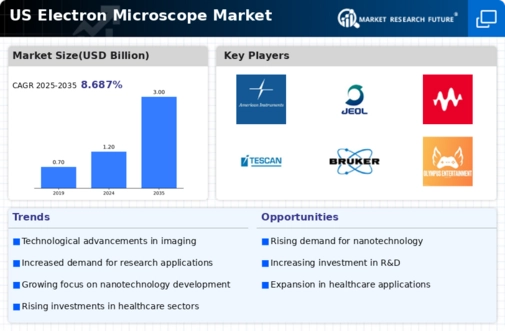The electron microscope market is characterized by a dynamic competitive landscape, driven by technological advancements and increasing demand across various sectors, including materials science, biology, and nanotechnology. Key players such as Thermo Fisher Scientific (US), JEOL (JP), and Hitachi High-Technologies (JP) are at the forefront, each adopting distinct strategies to enhance their market positioning. For instance, Thermo Fisher Scientific (US) emphasizes innovation through continuous R&D investments, focusing on developing high-resolution imaging solutions that cater to the evolving needs of researchers. Meanwhile, JEOL (JP) has been expanding its product portfolio to include advanced electron microscopes that integrate AI capabilities, thereby enhancing user experience and operational efficiency. These strategic initiatives collectively contribute to a competitive environment that is increasingly focused on technological differentiation and customer-centric solutions.
In terms of business tactics, companies are localizing manufacturing and optimizing supply chains to enhance operational efficiency and reduce costs. The market structure appears moderately fragmented, with several players vying for market share. However, the influence of major companies like Thermo Fisher Scientific (US) and Hitachi High-Technologies (JP) is substantial, as they leverage their extensive resources and technological expertise to shape market dynamics.
In October 2025, Thermo Fisher Scientific (US) announced the launch of a new line of ultra-high-resolution electron microscopes designed for advanced materials characterization. This strategic move is likely to strengthen its competitive edge by addressing the growing demand for precise imaging in research and industrial applications. The introduction of these cutting-edge instruments not only showcases the company's commitment to innovation but also positions it favorably against competitors who may not have similar capabilities.
In September 2025, JEOL (JP) unveiled a partnership with a leading AI technology firm to enhance the analytical capabilities of its electron microscopes. This collaboration aims to integrate machine learning algorithms into the imaging process, potentially revolutionizing data analysis in electron microscopy. Such strategic alliances indicate a trend towards the incorporation of AI in scientific instrumentation, which may significantly improve the efficiency and accuracy of research outcomes.
In August 2025, Hitachi High-Technologies (JP) expanded its presence in the North American market by establishing a new service center in California. This expansion is indicative of the company's strategy to enhance customer support and service delivery, thereby fostering stronger relationships with clients. By localizing its operations, Hitachi High-Technologies (JP) is likely to improve response times and service quality, which are critical factors in maintaining competitive advantage in the electron microscope market.
As of November 2025, current trends in the electron microscope market include a pronounced shift towards digitalization, sustainability, and the integration of AI technologies. Strategic alliances are increasingly shaping the competitive landscape, as companies collaborate to leverage complementary strengths and enhance product offerings. Looking ahead, it appears that competitive differentiation will evolve from traditional price-based competition to a focus on innovation, technological advancements, and supply chain reliability. This shift may redefine market dynamics, compelling companies to invest in cutting-edge technologies and sustainable practices to maintain their competitive edge.























Leave a Comment